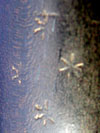An interesting German (?) flutePerhaps you can help identify the flute below, or at least suggest a country of origin. There is some lettering visible on it, but not clear enough to make an identification. There is however a maker's mark. |
|
| Four 6-pointed stars appear on the upper body, two on the lower body and one on the foot, just below the Eb key plate. As can be seen, stars may not be the best description. Perhaps asterisks or snowflakes? Note also the somewhat irregular spacing. |  |